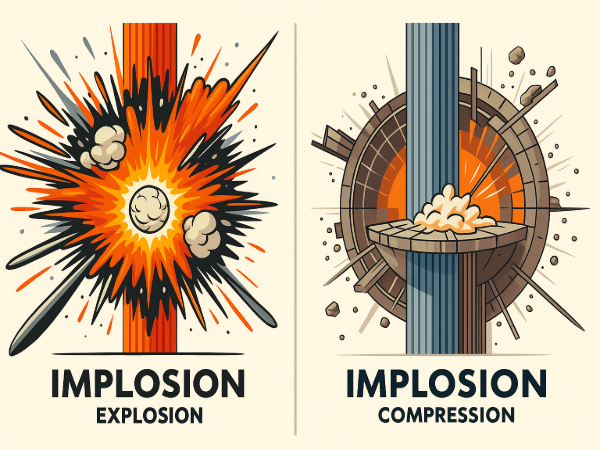Implosion vs Explosion: Understanding the Forces of Inward and Outward Energy
A Complete Guide to the Differences, Mechanisms, and Real-World Examples

Implosion vs Explosion refers to two powerful yet opposite phenomena of energy transformation. An explosion is a rapid outward release of energy, heat, and matter, creating shockwaves and loud noise, while an implosion is an inward collapse caused by overwhelming external pressure that crushes a structure or system toward its center. The key difference lies in direction: explosions push outward, and implosions pull inward.
Introduction
Energy governs the universe, and its sudden release can manifest in astonishing ways. Among the most dramatic energy events are implosions and explosions. While the words sound similar, their physical processes differ greatly. An explosion tears outward, scattering fragments and releasing energy into the environment, whereas an implosion collapses inward, concentrating energy into a smaller space.
Understanding these phenomena is crucial in science, engineering, military applications, and even natural events like supernovae. This article provides a detailed, 2000-word exploration of Implosion vs Explosion, their mechanisms, examples, scientific principles, and real-world implications.
What Is an Explosion?
Definition
An explosion is a rapid outward release of energy and matter from a central point, often accompanied by shockwaves, intense heat, and sound.
Mechanism of Explosions
Explosions typically occur when:
Energy builds up inside a system.
Internal pressure exceeds structural limits.
The system bursts outward, releasing energy violently.
This rapid expansion sends shockwaves through the surrounding environment, making explosions highly destructive.
Real-World Examples of Explosions
Chemical Explosions: Fireworks, dynamite, or gas cylinder blasts.
Nuclear Explosions: Release massive amounts of heat, light, and radiation.
Volcanic Eruptions: Gases and magma blast outward with explosive force.
Everyday Explosions: Popping balloons or soda cans bursting.
What Is an Implosion?
Definition
An implosion is the opposite of an explosion — a sudden inward collapse caused by external pressure overwhelming internal strength.
Mechanism of Implosions
Implosions occur when:
External pressure far exceeds internal resistance.
The structure collapses inward.
Energy is concentrated in a smaller volume instead of spreading outward.
Real-World Examples of Implosions
Submarine Implosions: Deep-sea pressure crushing a vessel’s hull.
Building Implosions: Controlled demolitions where structures collapse inward.
Star Collapses: Core collapse in supernovae and black hole formation.
Vacuum Tube Implosions: CRT screens collapsing inward if broken.
Scientific Principles Behind Explosions
Physics of Expansion
Explosions release stored energy rapidly, causing gas or matter to expand outward.
Chemical Energy: Combustion of fuel releases heat and gases.
Nuclear Energy: Fission or fusion releases massive amounts of energy.
Mechanical Energy: Rapid release of compressed air or steam.
Effects of Explosions
Shockwaves: Travel faster than sound and damage structures.
Thermal Energy: Creates extreme heat and fire.
Fragmentation: Debris scatters outward, causing destruction.
Scientific Principles Behind Implosions
Physics of Collapse
Implosions rely on external pressure crushing inward. When internal support fails, energy compresses into a smaller volume.
Key Phenomena in Implosions
Cavitation: Small vapor bubbles in liquid collapse inward.
Star Core Collapse: Gravitational implosions trigger supernovae.
Vacuum Effects: A container collapsing due to pressure difference.
Effects of Implosions
Concentration of Force: Unlike explosions, energy is focused inward.
Silent but Powerful: Implosions may be quieter but deadlier.
Structural Collapse: Buildings or ships crushed inward.
Implosions in Nature and Technology
Astrophysics
Stars undergo gravitational implosions before exploding into supernovae.
Black holes form when implosions compress matter into infinite density.
Engineering Applications
Nuclear Weapons: Implosion designs compress plutonium to critical mass.
Demolition Engineering: Buildings collapse inward to minimize debris spread.
Medical Technology: Cavitation implosions used in ultrasonic treatments.
Explosions in Nature and Technology
Natural Explosions
Volcanoes: Pressure buildup inside Earth creates explosive eruptions.
Lightning & Thunder: Superheated air expands explosively.
Meteor Impacts: Release massive outward energy on collision.
Human-Made Explosions
Mining & Construction: Explosives used to break rock.
Military Applications: Bombs, grenades, and artillery.
Energy Sector: Controlled explosions in engines and rockets.
Similarities Between Implosions and Explosions
Despite their opposite directions, they share:
-
Rapid Energy Transformation
-
Extreme Pressure Differences
-
Powerful Physical Effects
-
Destructive Potential
Both can reshape environments, destroy structures, and alter natural systems.
Differences in Impact and Consequences
Explosion: Outward destruction, widespread shockwaves, fire risk.
Implosion: Localized collapse, extreme compression, sudden inward damage.
For example:
An explosion in a city can devastate large areas.
An implosion can silently destroy a submarine deep underwater.
Implosion vs Explosion in Popular Culture
These phenomena appear in movies, literature, and media:
Explosions: Action films showcasing fiery blasts.
Implosions: Sci-fi depictions of collapsing stars or structures.
They serve as powerful symbols of energy release, transformation, and destruction.
Why Understanding the Difference Matters
Engineering Safety: Preventing pressure vessel failures.
Military Strategy: Designing weapons with intended effects.
Science Education: Teaching physics and natural phenomena.
Disaster Preparedness: Knowing risks from explosions or structural collapses.
Conclusion
The debate of Implosion vs Explosion reveals two equally dramatic but opposite forces of nature. Explosions scatter energy outward in fiery, destructive blasts, while implosions pull inward, collapsing structures under overwhelming external pressure. Both showcase the immense power of energy transformation, shaping everything from fireworks to black holes.
By understanding their differences, mechanisms, and real-world examples, we gain deeper insight into the forces that govern both natural and human-made events. Whether in science, engineering, or nature, the study of implosions and explosions reminds us of the delicate balance of pressure, energy, and matter in the universe.



